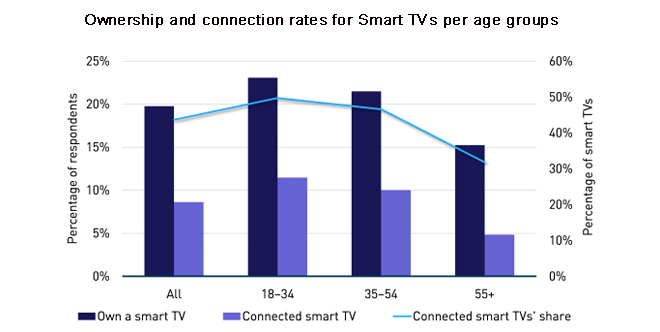Europe's online source of news, data & analysis for professionals involved in packaged media and new delivery technologies

Most smart TV owners do not connect their TVs to the Internet
In a consumer survey conducted in five countries in Europe and the USA, more than a third of respondents were interested in buying a smart-TV set, but of the one in five respondents who claimed to own a smart TV, fewer than half of those had actually connected it to the Internet. These are the latest results from Analysys Mason's new report, The Connected Consumer Survey 2013: TV and video.
Surveying 6,600 consumers in France, Germany, Poland, Spain, the UK and the USA, the analysts believes that actual ownership levels for smart-TV sets may be higher than that reported because some people may own a smart TV without even realising it, having purchased the TV for other features such as picture quality or the attractive form factor.
Of the respondents who owned a TV (smart or otherwise), 7% had an Internet-capable Blu-ray player connected to the TV set. "This represents an alternative, and cheaper, route into the world of smart TV for those who do not wish to buy a new TV set, bringing the total penetration of smart TVs and associated peripheral devices to more than a quarter of respondents," says analyst Cesar Bachelet.
On the other hand, streaming media devices, such as Apple TV or Roku Internet set-top boxes, which typically are single-purpose devices offering access to a more limited range of content than smart TVs, were owned by just 1 in 20 of our respondents.
Encouragingly for CE manufacturers, more than a third (36%) of respondents who do not yet own a smart TV were interested in buying one, with interest peaking at 42% within the key 35-54 age group - these respondents typically have a higher income than their younger peers (18-34 year olds), but are more interested in new technology than older respondents (aged 55 or over).
"Although CE manufacturers and their distribution channels, particularly retailers, have been successful in getting smart TVs into consumers' homes, they haven't done so well when it comes to getting consumers to actually use the 'smart' functionality within the sets," notes Bachelet. Overall, fewer than half of smart-TV owners in the panel reported that they had connected their TVs to the Internet.
The low average penetration of connected smart TVs as a proportion of smart TVs (connection rate) of 44% (ranging from 50% of 18?34-year-olds to 32% of those aged 55 or over), is a lost opportunity for CE manufacturers aiming to develop new revenue streams and form deeper relationships with consumers.

The analyst posits that stakeholders need to address the following:
Lack of compelling content and applications, and limited differentiation: Although most smart TVs offer a relatively wide range of content and applications, most of it is fairly generic, and a lot of it may be irrelevant or uninteresting to many consumers. This issue is likely to be addressed as CE manufacturers increasingly form partnerships with local content owners, which can include pay-TV operators.
Poor user interfaces: Perhaps more importantly than content issues, the 'smart' functionality of these sets is generally not integrated with linear viewing, which still remains the main purpose of the smart TV set. The 'smart' experience is delivered through a range of disjointed apps, making interaction difficult. Some CE manufacturers, such as Samsung, are beginning to address this through features such as content recommendation, voice and motion control.
"By creating an intuitive experience that seamlessly combines the efficiency of traditional broadcasting with the diversity of the Internet, CE manufacturers can drive consumers to effortlessly embrace the 'smart' functionality within their TV sets. Only then will smart TVs truly be successful," concludes Bachelet.
Story filed 29.05.13




















